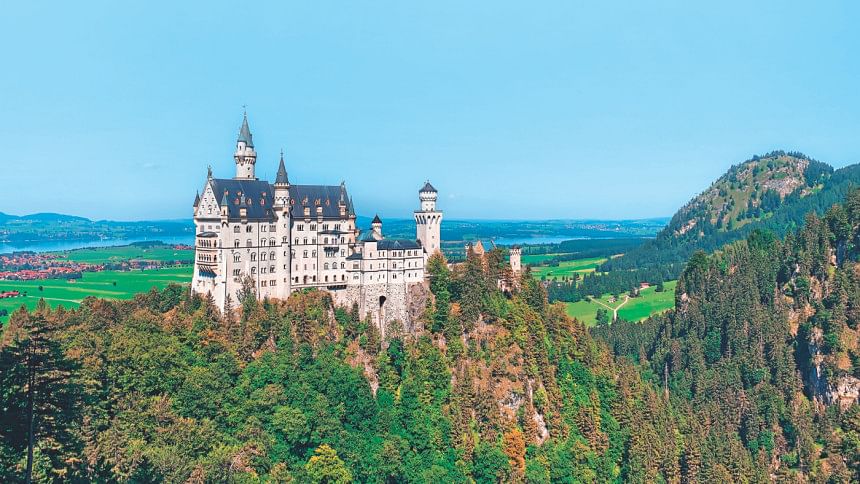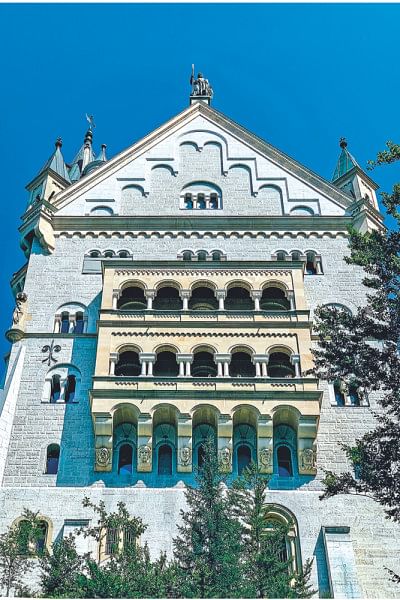Ludwig II’s fairy tale castle

During my trip to Europe, one of the destinations I had planned to visit was Neuschwanstein Castle. I thought it would be just another historical building, but it is so much more than that.
We were going to start our journey from the main train station in Munich. Upon reaching the counter, we met our two eccentric tour guides for the day—Josh and Dan. After a brief chat regarding what we would be doing, we boarded the bus to the castle.
On the way, we were treated to their extensive knowledge of Bavaria and its history. The journey was made even more pleasant by the sights we saw from our windows. First, we saw a beautiful turquoise-coloured river flanked by green hills while we were crossing a bridge near Schongau. Then, we were greeted by the majestic Bavarian Alps. Dan was the expert of these regions and he made sure we took out our phones at precisely the right times for a great photo-op.
After around two hours, we got off the bus at our final stop: Hohenschwangau, a village that also serves as a gathering point for tourists wanting to visit the two castles in the vicinity. Dan and Josh guided us through the various landmarks and took us to the biggest souvenir shop in the village. They then presented us with two options: Dan would allow for an hour-long lunch break before heading off towards the castle via a bus, while Josh would take the hiking tracks through the hills for an hour-long trek. I chose to say with Dan as I was still pretty exhausted from the flight the night before.

Dotted with souvenir shops and exquisite cafes, Hohenschwangau is the perfect place for a condensed Bavarian countryside experience. You can take a stroll through the streets near the churches for some great views of the castles or relax at a local café while having delectable desserts fresh from the oven.
After we were done, it was time to finally go visit the castle. We boarded a bus that took us to the foot of Mary's Bridge. This place offers the best view of Neuschwanstein Castle in the entire region. After struggling through the horde of tourists on the bridge itself, I managed to get some great shots.
Neuschwanstein Castle had served as one of the primary inspirations for many of the fairy-tale castles we've seen in Disney movies. Positioned at the top of a hill, it sits proudly as a testament to the cutting-edge architecture available at that time. The towers and turrets accentuate the castle's appearance to a point where it looks like it's straight out of an illustration book. The castle's construction was ordered by King Ludwig II, the king of Bavaria at the time, in 1867. It was made as a private refuge for Ludwig who was fascinated by the castle his father had constructed just a few kilometres away. Ironically, Ludwig could only stay at the castle for 11 nights before he was accused of madness and taken away to a remote place in Bavaria. The castle's construction lasted until 1886 and it remains incomplete to this day. It is truly a sight to behold from the great vantage point at Mary's Bridge.

I followed Dan towards the base of the castle and after 20 minutes, we were standing right in front of the tall, imposing gates. The authorities responsible for the tours inside the castle only allow a limited number of people per time-slot. Luckily, I didn't have to wait for longer than five minutes.
After climbing five flights of stairs, we got to the entrance of the throne room. Taking pictures wasn't allowed inside. We were given small speaker devices which would relay the narration of the tour guide.
The throne room was one of the most opulent spaces I had ever seen. The dome-shaped ceiling rose 50 feet above us and was decorated with Romanesque, Gothic, and Byzantine art. The mosaic floor was a technical marvel of the time comprised of millions of little blocks of stone. An ornate chandelier hung from the ceiling. Its candle-holders were occupied by recently-placed electric lights that mar the grandiosity of it all. Perhaps, these lights are reflective of the great irony of the throne room—it doesn't have an actual throne. A platform is there, but Ludwig II passed away before it could be placed.
The castle also incorporated facilities that were way ahead of its time. There was an air conditioning system that controlled air flow through vents, the toilets had working flushes, and a sink in Ludwig's bedroom could directly pull water from a nearby lake.
In the bedroom, the intricately-detailed wooden bed apparently took four years to complete. It is layered with sharp "towers" that descend in height as it reaches further inwards. However, the actual size of the sleeping space is quite small.
Neuschwanstein Castle will forever stand as one of the bastions of a time long gone by. It is representative of a controversial history—a tragic irony and opulence that knew no bounds. After exploring all the rooms and stepping on to a balcony overlooking a lake and the Hohenschwangau Castle, I wondered what might have gone through Ludwig's mind when he stood right here all those years ago on his last day, waiting to be taken away. Did he feel proud of this achievement? Or was he regretful of the fact that he would not live to see his creation be completed?
Shahrukh Ikhtear roams the mystical plains of adulthood in search of the fabled work-life balance. Help him out with good music or just say wholesome things at [email protected].

 For all latest news, follow The Daily Star's Google News channel.
For all latest news, follow The Daily Star's Google News channel. 



Comments